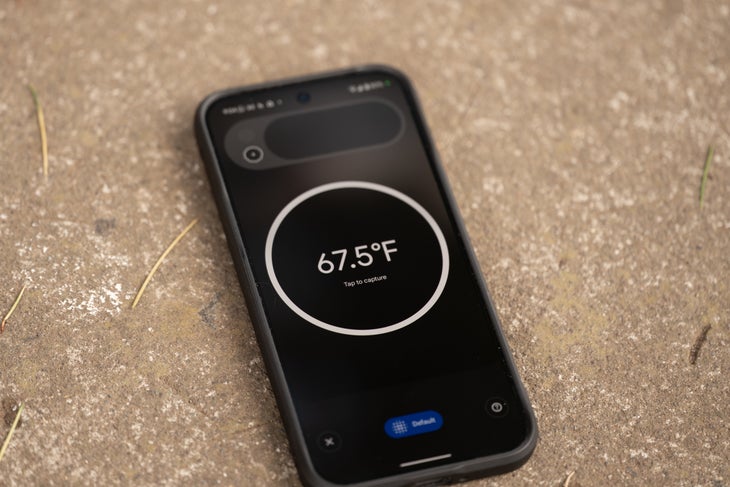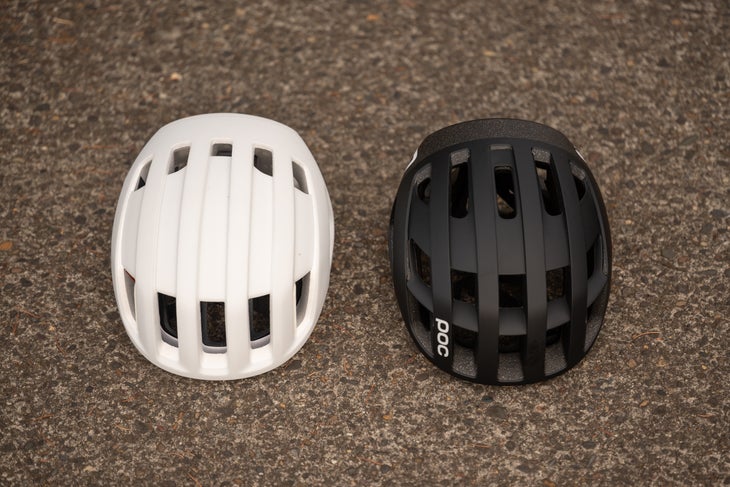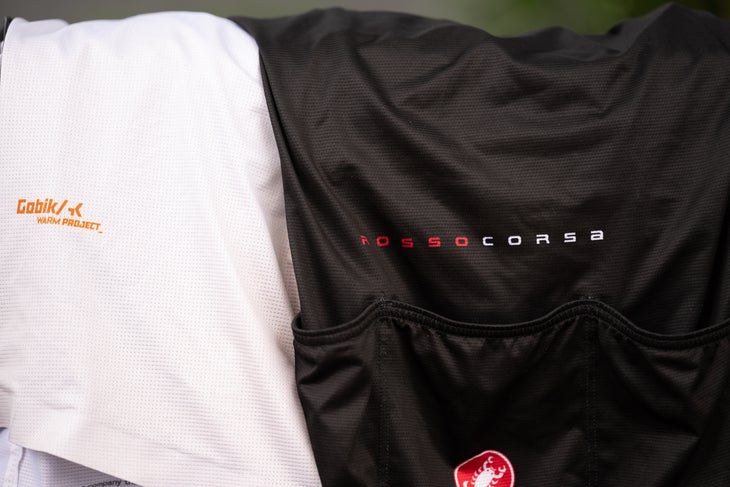Heat has become a major factor in modern cycling, including during many stages of the Tour de France.
It’s well known that heat kills performance. A 2000 study called “Effects of heat stress on physiological responses and exercise performance in elite cyclists” found that “power output was 6.5% lower” at 32 degrees C (90 degrees F) compared to 23°C (73 degrees F).
Heat management is one of the few performance avenues left where our understanding is still developing and the peloton is experimenting. We took a look at how heat training became the peloton’s hottest performance enhancer, but is there a simple piece that’s being overlooked?
Team Visma-Lease a Bike used a team kit in the Tour that’s primarily black. Meanwhile UAE Team Emirates-XRG’s kit is mostly white. Given that black absorbs heat and that heat kills performance isn’t that an obvious issue?
But you know the saying about assumptions, though. So we decided to do some temperature testing of our own. Does using a black helmet, water bottle, or jersey mean increased temperature? Here’s what we found.

Temperature testing protocol
The setup on this test is pretty simple, but my home base being Portland I first needed sun. With that in place, the next detail was a way to check the temps. For that, I used my Google Pixel 9 Pro XL, which has a thermometer built into the rear, and an instant read meat thermometer for the bottles.
From there I grabbed a black Camelbak Podium bottle, a white Hydrapak Breakaway Surge bottle, a white Gobik Infinity short sleeve jersey, and a black Castelli Aero Race 8s jersey and placed them in direct sunlight. For the helmets I wanted two options that were as close as possible in design. To that end I used the POC Cytal MIPS and the POC Cytal Lite helmets with the Cytal being white and the Cytal Lite being black. I put fans in front of everything to simulate the movement on a bike.
For measurement I checked each subject across six temperature readings. For the bottles I tested the water temperature and the jerseys I tested the same spot on the back where the color was solid.
The helmets were a little more complicated because the design of a helmet is essentially insulation. That meant I checked the outside temperature at a similar solid spot on the upper but I also tested the inside on the forehead padding. It’s one of the few spots that your skin comes into close contact with the padding and the padding is close to the helmet outer without much airgap.

Temperature testing results
Jersey
| Time (in minutes) | 0 | 10 | 20 | 30 | 40 | 50 |
| Black jersey temperature (F) | 119.2° | 144.7° | 135.8° | 140.2° | 136.5° | 134° |
| White jersey temperature (F) | 108.5° | 117° | 115.5° | 117.4° | 115.5° | 113.6° |
Water Bottle
| Time (in minutes) | 0 | 10 | 20 | 30 | 40 | 50 |
| Black bottle water temperature (F) | 73° | 84° | 95° | 100° | 106° | 109° |
| White bottle water temperature (F) | 72° | 81° | 88° | 93° | 99° | 102° |
Helmet
| Time (in minutes) | 0 | 10 | 20 | 30 | 40 | 50 |
| Black helmet, inside temperature (F) | 102.9° | 118.2° | 116.7° | 110.5° | 117.9° | 111.4° |
| Black helmet, outside temperature (F) | 120.6° | 135° | 164.1° | 169.7° | 175.1° | 175.4° |
| White helmet, inside temperature (F) | 95.5° | 114° | 108.8° | 107.9° | 110.7° | 110.8° |
| White helmet, outside temperature (F) | 94.5° | 117.4° | 118.5° | 118.1° | 118.0° | 119.5° |
The takeaway and what you can do on your own rides
The results for the bottles and jerseys are pretty straightforward. After an hour in the sun the water in the black bottle was 6 degrees F warmer. Use a white bottle and your drink will stay cooler longer.
For the jerseys, you’ll notice that the white jersey starts cooler. I suspect that’s because the temperature goes up quickly enough in the black jersey that it was already heating up in the time of moving the jersey from inside to outside in the sun, getting the phone out, and actually measuring it.
The result is that at the end of the test the black jersey was 20.4 degrees warmer, but if we subtract the initial 10.7-degree differential, then the difference reduces to 9.7 degrees. I’m not entirely sure that’s a fair thing to do given both jerseys spent the same amount of time in the sun but no matter how you slice it, the black jersey is a bad idea.
Even 10 degrees is substantial and there’s the potential that it’s actually higher. Don’t wear a black jersey if you can help it, and Team Visma-Lease a Bike should probably think about different colors.

Now the helmet test was a bit more surprising. Like the black jersey, the black helmet shot up in temperature so quickly it was impossible to measure from an even baseline. I brought them both out of a cool house, laid them down on something white and measured the white helmet outside then the black helmet outside. The black helmet was immediately hot to the touch and it only got hotter. The inside temperature was also hotter from the get go.
The interesting thing is that the white helmet started much cooler but that didn’t last. While the interior and the exterior of the white helmet started as almost the same and only slowly diverged, the temperature on the inside of the helmet was essentially the same for both colors after the test.
It would seem that helmet foam is an excellent insulation and the airflow probably helps even further to negate the effect of the darker exterior. Neither team uses a black helmet but it wouldn’t matter if they did. So go ahead and use whatever color helmet fits your style.

